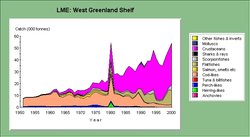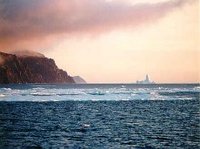West Greenland Shelf large marine ecosystem
Contents
Introduction Location of the West Greenland Shelf Large Marine Ecosystem. (Source: NOAA (West Greenland Shelf large marine ecosystem) )
The West Greenland Shelf Large Marine Ecosystem (LME) begins at Eirik Ridge on the southern tip of Greenland and extends along Greenland’s west coast. It encompasses a number of banks, including the Fyllas Bank. The waters of the West Greenland Current come from Greenland’s south coast, the Labrador Sea, and from East Greenland’s strong Irminger current. There is a strong link to the East Greenland Shelf LME (#19) because of the clockwise direction of the system of currents. The Davis Strait separates West Greenland from Canada. Changes in sea and air temperature appear to be the driving force of this LME.
Productivity
 Graph: LME West Greenland Shelf. (Source: NOAA)
Graph: LME West Greenland Shelf. (Source: NOAA) The West Greenland Shelf LME is considered a Class III, low (< 150 grams of Carbon per square meter per year) productivity, ecosystem based on SeaWiFS global primary productivity estimates. The LME is ice covered for parts of the year. There is a relatively long series of plankton and hydrographic samples allowing an exploration of the links between climate, physical oceanography, and abundance of major zooplankton and ichthyoplankton species (see Pedersen and Rice, 2001). The previously mentioned currents carry cod eggs and larvae in a clockwise direction around the southern part of Greenland, but there is a need to learn more about the patterns of occurrence of selected fish larvae end zooplankton over time and space and how those patterns relate to hydrographic features. Studies showed a decreasing trend in zooplankton abundance. Information on current velocity is scarce. The decline of cod, redfish and long rough dab stocks can be seen as consequences of changes in climate, temperature and salinity. Hydrographical conditions seem to be changing in the Irminger Sea to the east. NORWESTLAND has conducted surveys along 3 transects of study in the West Greenland coast, Store Hellefiske bank, Sukkertop bank and Fyllas bank, where sea temperatures and salinities have been measured.
Fish and Fisheries
 (Source: NOAA)
(Source: NOAA) The commercial fish species are Atlantic cod, redfish, Greenland halibut, long rough dab, wolffish, sandeels and northern shrimp. Annual landings of these commercial fish species show major changes over the past century. Landings of cod, redfish and long rough dab have declined. Cod was the most important fish species in Greenland waters, with annual catches peaking at levels between 400,000 and 500,000 tons in the 1960s. Low recruitement played an important role in the collapse of the cod fishery since the 1960s. The decline is in amounts as well as in the sizes of fish at age. In the same period, however, the catches of Greenland halibut and northern shrimp increased.
The periodic fluctuations of cod stocks have been linked to changes in sea and air temperature. The increases of cod stocks coincided with warm periods, and the declines corresponded to cool periods (see Hovgard and Buch, 1990). The cod fishery displaced itself towards the South. One oceanographic hypothesis links variation in larval and juvenile drift to recruitment variability in West Greenland waters (see Buch et al. 1994 and Pedersen 1994). According to the predation-release hypothesis, the present abundance of shrimp in this LME may partly be the result of a lower abundance of cod and redfish (see Horsted 1989). According to the by-catch hypothesis, large numbers of redfish, Greenland halibut, polar cod, cod and others, were caught and discarded in the West Greenland shrimp fishery (see Pedersen and Kanneworff 1995). But it is important to also consider the added influence of changes in fishery technology and effort on cod stocks. Our colleagues at the University of British Columbia Fisheries Center have detailed fish catch statistics on this LME.
Pollution and Ecosystem Health
The International Cod and Climate Change Program (CCC) studies the response of different cod populations to climate changes in various regions of the cod’s North Atlantic range.
Socio-economic Conditions
 (Source: Jamie Stewert, NOAA)
(Source: Jamie Stewert, NOAA) Greenland made the transition from a nation of hunters to a nation of fishermen, primarily cod, over the course of this century. A rich Atlantic cod fishery started in the 1920s after a general warming of the Arctic. It developed from a local, small-boat fishery to an international offshore fishery of primarily trawlers shery of primarily trawlers.
Governance
Both Canada and Greenland share jurisdiction of this LME. Canadian fisheries after 1945 were regulated under ICNAF (International Commission for the Northwest Atlantic Fisheries), consisting of all the industrialized fishing nations of the world operating in that area. ICNAF’s effectiveness, however, was limited by the voluntary nature of compliance to its rules. With the increase in foreign fishing fleets after World War II, the cod fishery expanded greatly. The limited development of Canada’s domestic fleet prompted Canada to establish a 200-mile Exclusive Economic Zone in 1977. The Greenland Institute of Natural Resources is responsible for providing scientifically sound management advice to the Greenlandic government.
References
- Blindheim, Johan and Hein Rune Skjoldal, “Effects of climatic changes on the Biomass Yield of the Barents Sea, Norwegian Sea, and West Greenland Large Marine Ecosystems. 1993, Sherman, Alexander, Gold, “Large Marine Ecosystems: Stress, Mitigation, and Sustainability, 185-198. ISBN: 087168506X.
- Buch, E., S.A. Pedersen, M.H. Ribergaard, 2003. Ecosystem variability and regime shift in West Greenland waters. J. Northw. Atl. Fish. Sci.
- Horsted, S.A., 2000. A Review of the Cod Fisheries at Greenland, 1910-1995. J. Northw. Atl. Fish. Sci. Vol. 28, 1 - 109.
- Hovgard, H. and E. Buch, "Fluctuation in the Cod Biomass of the West Greenland Sea Ecosystem in Relation to Climate," in Kenneth Sherman, et al. (eds.), Large Marine Ecosystems: Patterns, Processes and Yields (Washington, D.C.: American Association for the Advancement of Science, 1990) pp.36-43. ISBN: 0871683849.
- Hansen, P.M. 1949. "Studies on the Biology of the Cod in Greenland Waters," Rapp. P.v. Reun. Cons. Int. Explor. Mer 123: 1-83.
- Pedersen, S.A., and E.L.B. Smidt 2000. Zooplankton distribution and abundance in West Greenland waters, 1950-1984. Journal of Northwest Atlantic Fishery Science 26:45-102.
- Pedersen, S.A. 2001. Fish. In, E. W. Born and J. Bøcher (Editors): The Ecology of Greenland. Ministry of Environment and Natural Resources, Ilinniusiorfik, Nuuk 2001. Page 155-169. ISBN: 8755815146.
- Pedersen, S.A. and D. Zeller. 2001. A mass balance model for the West Greenland marine ecosystem. In: Guenette, S., Christensen, V. and Pauly, D. (eds). Fisheries impacts on North Atlantic Ecosystems: Models and Analyses. Fisheries Centre Research Reports 9(4). P. 111-127.
- Pedersen, S.A. and J. Rice. 2002. Dynamics of fish larvae, zooplankton, and hydrographical characteristics in the West Greenland Large Marine Ecosystem 1950-1984. In: Large Marine Ecosystems of the North Atlantic. Changing States and Sustainability. K.S. Shermann, H.-R. and Skjoldal (eds). Chapter 5. Elsevier Science. p.151-193. ISBN: 0871683849.
- Pedersen, S.A., C.S. Simonsen, and L. Storm. 2002. Northern shrimp (Pandalus borealis) recruitment in West Greenland waters. Part I. Distribution of Pandalus shrimp larvae in relation to hydrography and plankton. Journal of Northwest Atlantic Fishery Science 30:19-46.
- Pedersen, S.A. and L. Storm. 2002. Northern shrimp (Pandalus borealis) recruitment in West Greenland waters. Part II. Lipid classes and fatty acids in Pandalus shrimp larvae: implications for survival expectations and trophic relationships. Journal of Northwest Atlantic Fishery Science 30: 47-60.
- Petersen, H., H. Meltofte, S. Rysgaard, M. Rasch, S. Jonasson, T.R. Christensen, T. Friborg, H. Søgaard, and S.A. Pedersen. 2001. The Arctic. In: Climate Change Research - Danish Contributions. Danish Meteorological Instititute. DMI Ministry of Transport. Gads Forlag. P. 303-330.
- Reuss, N., and L. K. Poulsen. 2002. Evaluation of fatty acids as biomarkers for a natural plankton community. A field study of a spring bloom and a post-bloom period off West Greenland. Marine Biology 141: 423-434.
| Disclaimer: This article is taken wholly from, or contains information that was originally published by, the National Oceanic and Atmospheric Administration (NOAA). Topic editors and authors for the Encyclopedia of Earth may have edited its content or added new information. The use of information from the National Oceanic and Atmospheric Administration (NOAA) should not be construed as support for or endorsement by that organization for any new information added by EoE personnel, or for any editing of the original content. |